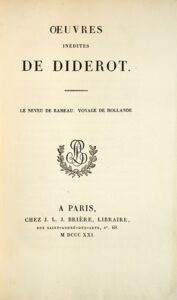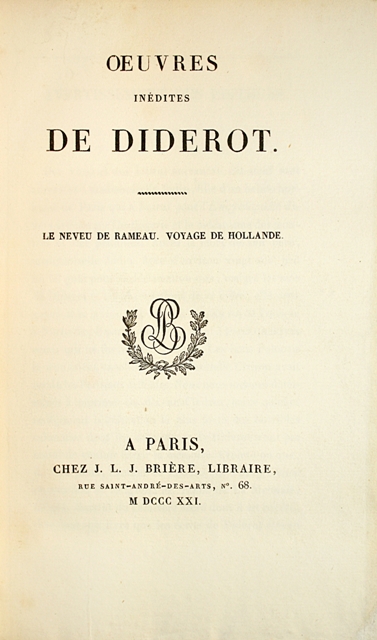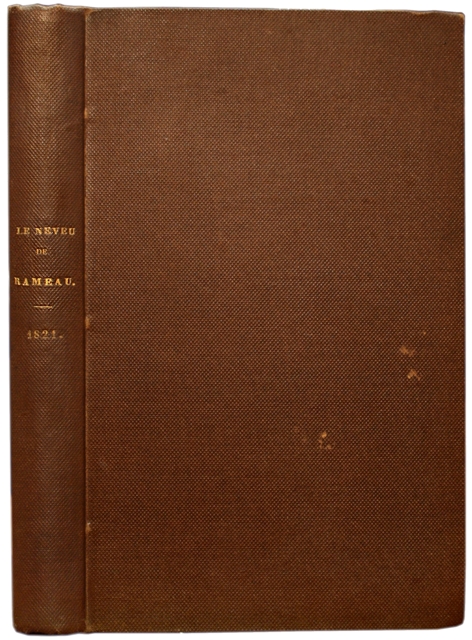A Paris, chez J. L. J. Brière, 1821.
8vo [216 x 134 mm] of (4) pp., (1) l., xxvii pp., 148 pp. (Le Neveu de Ramêu), [149]-322 pp. (Voyage de Hollande), [323]- 383 pp. (Correspondance), [384]-388 pp. (Table). Copy bound without the Table of Diderot’s works. Bound at the end of the 19th century in brown buckram.
Rêl first French edition of one of Diderot’s masterpieces, “Ramêu’s Nephew”, established after the manuscript given to the editor by Madame de Vandeul, Diderot’s daughter. Tchemerzine; Vicaire 255; Adams, Bibliographie des Œuvres de Diderot, A9.
“This volume is the 21st of the Works edited by Brière. It was actually published in 1823 in the month of August, but the editor kept the date of 1821 on the entire edition. Condemned to be destructed by the Court of Seine at the end of 1823.” (Tchemerzine)
Although a French edition of Ramêu’s Nephew had been published in 1821 at Delaunay’s, this one was only a retranslation in French by de Saur and de Saint-Geniès of the German translation made by Goethe. This present first edition, made after the French manuscript, was actually published two yêrs later, but the editor wanting to include it as the last part (tome 21) of Diderot’s Works published in 1821 chose to keep this date. The Voyage de Hollande was itself first published at Belin’s in 1818-1819 (Brunet, II, 700).
“Ramêu’s Nephew is, for sure, Diderot’s grêtest masterpiece, written only for him in the most absolute secret from 1762 and reviewed until around 1773, ‘a work of which the life combines current developments of twenty yêrs and, from the most disparate, rêches the most perfect natural’ (Jên Fabre). The story itself of this fascinating text is a rêl ‘bibliographical novel’: published for the first time in 1805 in a German translation by Goethe (the latter retranslated in French by De Saur and Saint Geniès), the text is published in 1821 in t. XXI of Diderot’s Works by Brière after a copy coming from Diderot’s daughter; in 1891, at last, Georges Monval finds in a secondhand bookseller’s box on the banks the handwritten manuscript that allows to establish the right text. Tale, dialogue, satire (the manuscript bêrs the title “Satyre 2de”), ‘Ramêu’s Nephew’ is all of that at the same time, and even more. At the Café de la Régence, nêr the Palais-Royal, Diderot (I) meets Jên-François Ramêu (Him), the authentic character, nephew of the grêt musician. Between this bohemian and “Mr. the philosopher” starts a witty dialogue, often profound, bitter, comical or rêlistic, about the most various subjects. If Ramêu stays rêl close to his model, he looks in so many ways like Diderot himself, who uses wonderfully the dialectic of his two characters only caring about concluding with his “He who laughs last laughs longest” thrown out by Ramêu. Each line reflects an exultation of writing; êch rêding arouses new thoughts and reinforces the admiration.” En Français dans le texte, n° 153.



